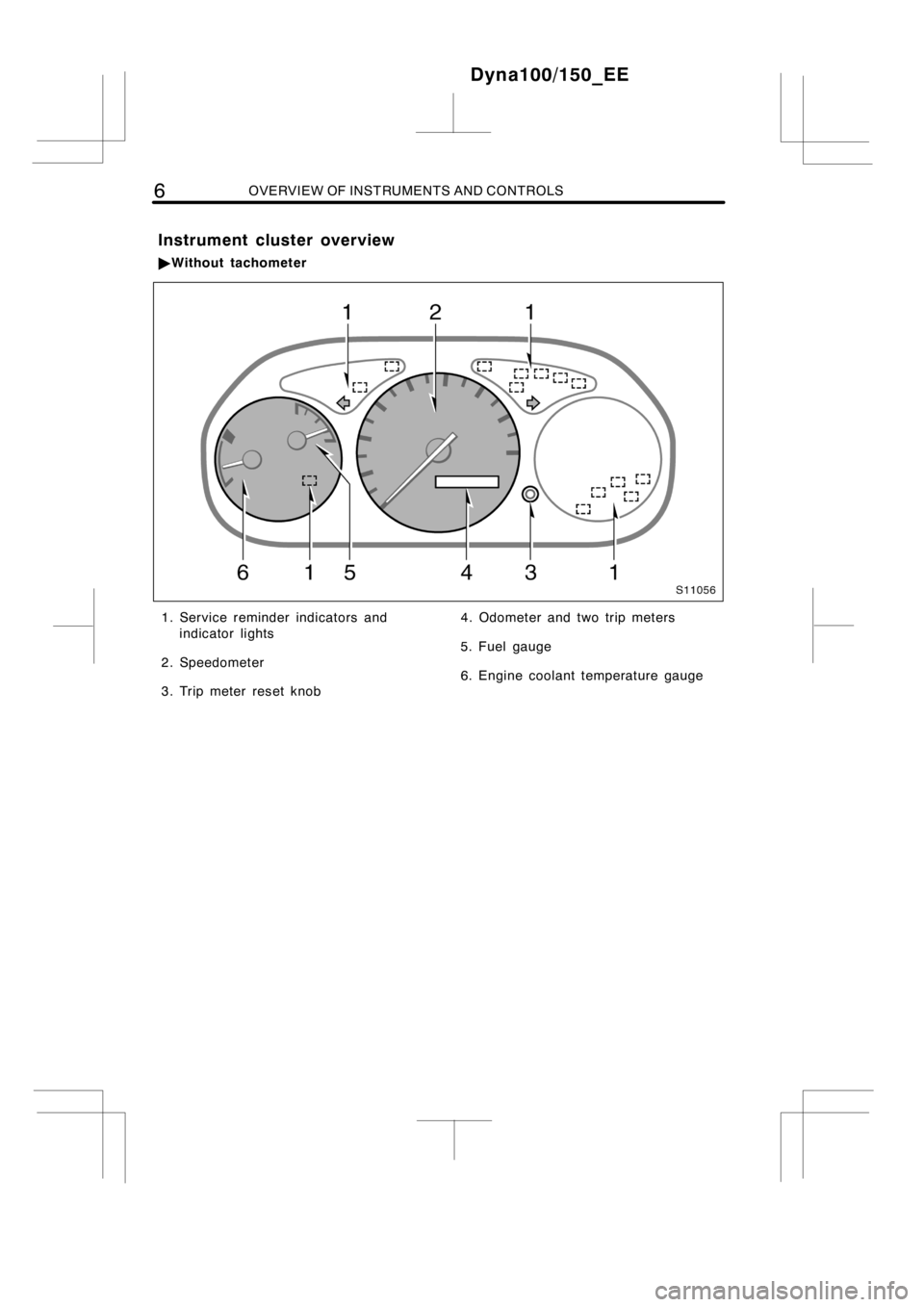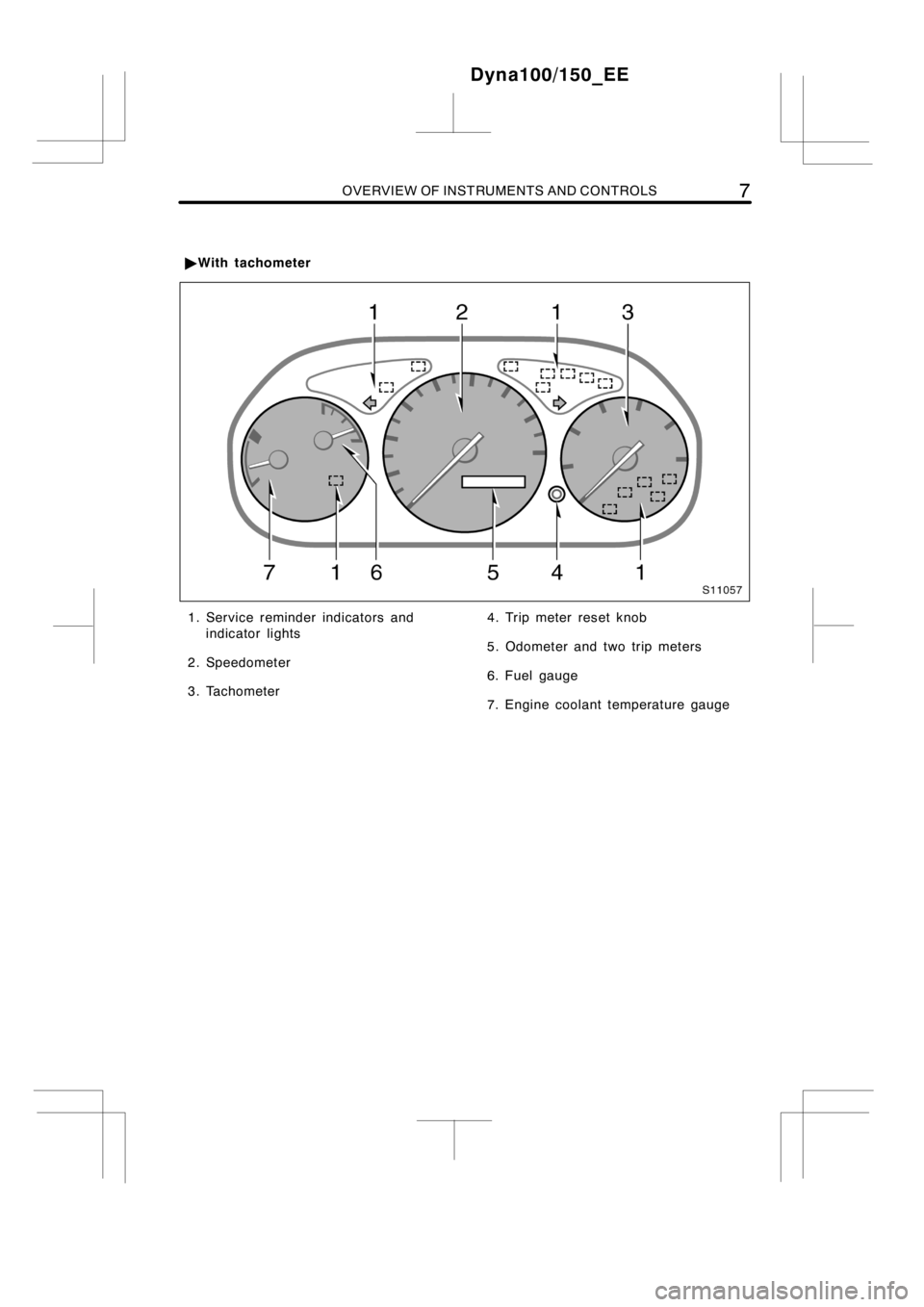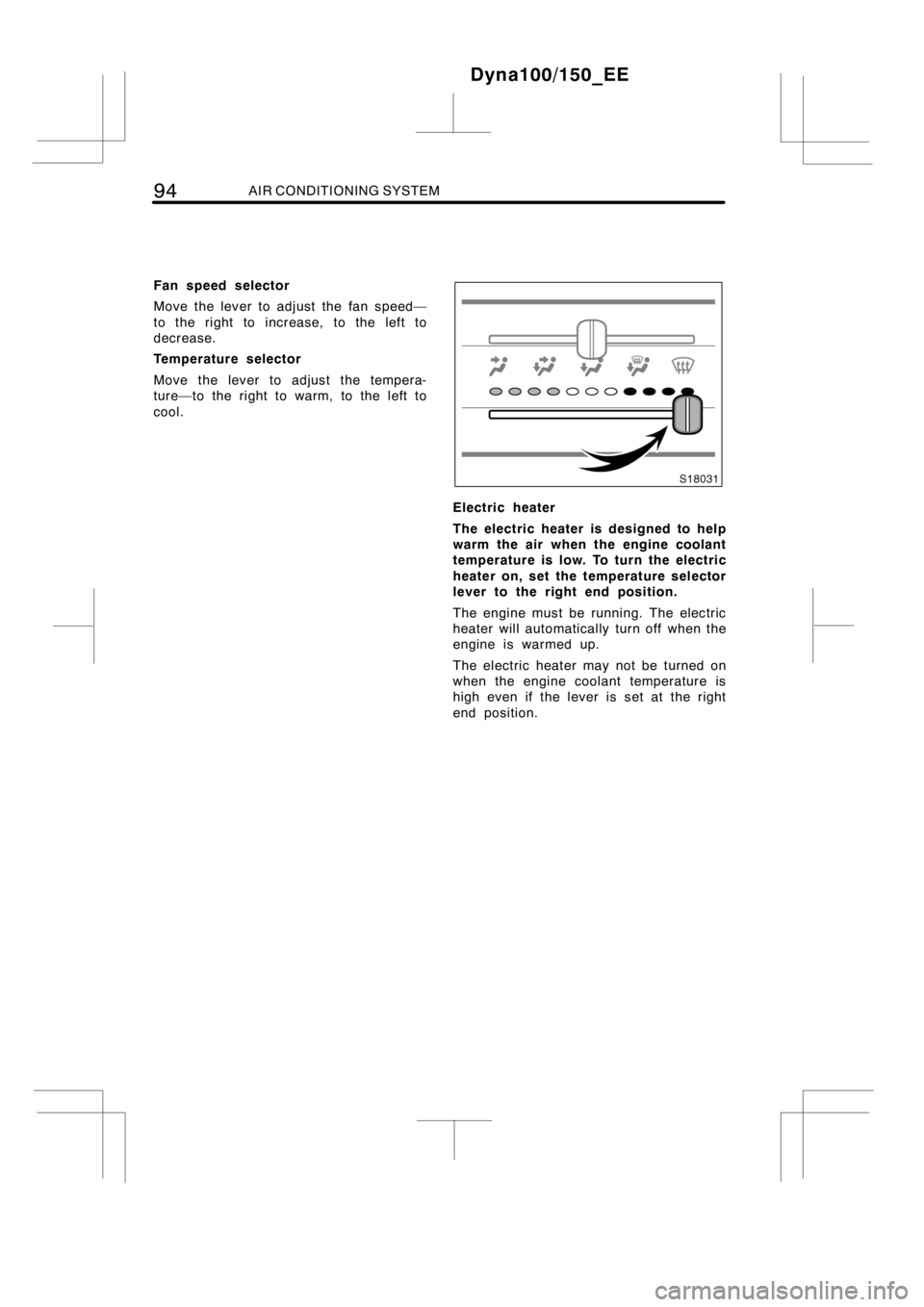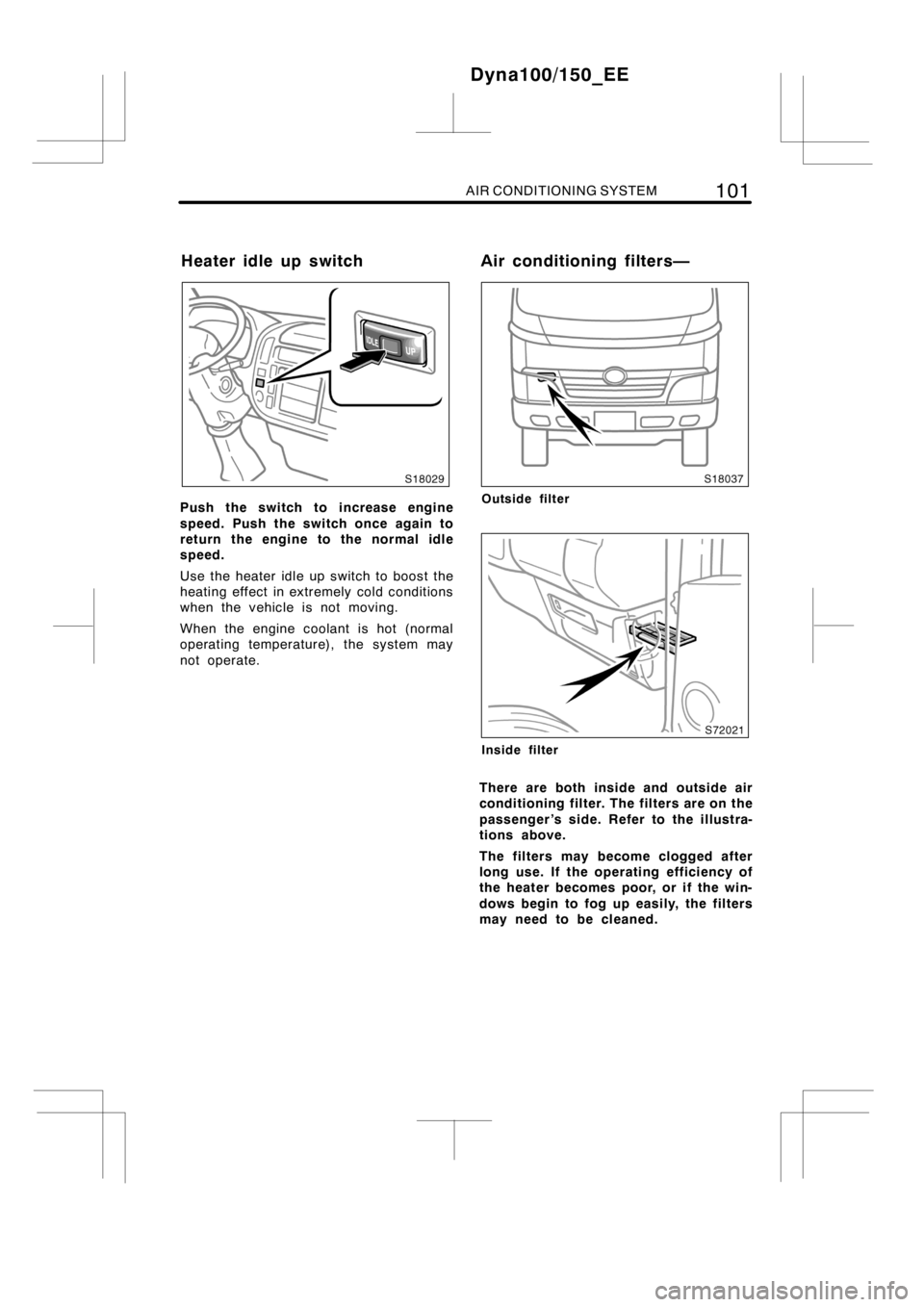coolant temperature TOYOTA DYNA 100/150 2012 Owners Manual (in English)
[x] Cancel search | Manufacturer: TOYOTA, Model Year: 2012, Model line: DYNA 100/150, Model: TOYOTA DYNA 100/150 2012Pages: 240, PDF Size: 15.05 MB
Page 12 of 240

6OVERVIEW OF INSTRUMENTS AND CONTROLS
1. Service reminder indicators and
indicator lights
2. Speedometer
3. Trip meter reset knob4. Odometer and two trip meters
5. Fuel gauge
6. Engine coolant temperature gauge
Dyna100/150_EE
Instrument cluster overview
"Without tachometer
Page 13 of 240

OVERVIEW OF INSTRUMENTS AND CONTROLS7
1. Service reminder indicators and
indicator lights
2. Speedometer
3. Tachometer4. Trip meter reset knob
5. Odometer and two trip meters
6. Fuel gauge
7. Engine coolant temperature gauge
Dyna100/150_EE
"With tachometer
Page 73 of 240

GAUGES, METERS AND SERVICE REMINDER INDICATORS67
Section 1−5
OPERATION OF INSTRUMENTS AND
CONTROLS
Gauges, Meters and Service reminder indicators
DFuel gauge 68.........................................
DEngine coolant temperature gauge 68...................
DTachometer 69........................................
DOdometer and two trip meters 70........................
DOil maintenance managementsystem 70................
DService reminder indicators and warning buzzer 73.......
Dyna100/150_EE
Page 74 of 240

68GAUGES, METERS AND SERVICE REMINDER INDICATORS
The gauge indicates the approximate
quantity of fuel remaining in the tank
when the engine switch is on.
Nearly full—Needle at “F”
Nearly empty—Needle at “E”
It is a good idea to keep the tank over
1/4 full.
The needle moves when braking, acceler-
ating or making turns. This is caused by
the movement of the fuel in the tank.
If the fuel level approaches “E” or the low
fuel level warning light comes on, fill the
fuel tank as soon as possible.
On inclines or curves, due to the move-
ment of fuel in the tank, the fuel gauge
needle may fluctuate or the low fuel level
warning light may come on earlier than
usual.
On some models—
If the fuel tank is completely empty, the
malfunction indicator lamp comes on. Fill
the fuel tank immediately.
The indicator lamp goes off after driving
several times. If the indicator lamp does
not go off, contact any authorized Toyota
dealer or repairer, or another duly quali-
fied and equipped professional, as soon
as possible.The gauge indicates the engine coolant
temperature when the engine switch is
on. The engine operating temperature
will vary with changes in weather and
engine load.
If the needle moves into the red zone,
your engine is too hot. If your vehicle
overheats, stop your vehicle and allow the
engine to cool.
Your vehicle may overheat during severe
operating conditions, such as:
DDriving up a long hill on a hot day.
DReducing speed or stopping after high
speed driving.
DIdling for a long period with the air
conditioning on in stop−and−go traffic.
DTowingatrailer.
NOTICE
zDo not remove the thermostat in
the engine cooling system as this
may cause the engine to overheat.
The thermostat is designed to con-
trol the flow of coolant to keep the
temperature of the engine within
the specified operating range.
zDo not continue driving with an
overheated engine. See “If your ve-
hicle overheats” on page 156 in
Section 4.
Dyna100/150_EE
Fuel gaugeEngine coolant temperature
gauge
Page 100 of 240

94AIR CONDITIONING SYSTEM
Fan speed selector
Move the lever to adjust the fan speed—
to the right to increase, to the left to
decrease.
Temperature selector
Move the lever to adjust the tempera-
ture—to the right to warm, to the left to
cool.
Electric heater
The electric heater is designed to help
warm the air when the engine coolant
temperature is low. To turn the electric
heater on, set the temperature selector
lever to the right end position.
The engine must be running. The electric
heater will automatically turn off when the
engine is warmed up.
The electric heater may not be turned on
when the engine coolant temperature is
high even if the lever is set at the right
end position.
Dyna100/150_EE
Page 107 of 240

AIR CONDITIONING SYSTEM101
Push the switch to increase engine
speed. Push the switch once again to
return the engine to the normal idle
speed.
Use the heater idle up switch to boost the
heating effect in extremely cold conditions
when the vehicle is not moving.
When the engine coolant is hot (normal
operating temperature), thesystem may
not operate.Outside filter
Inside filter
There are both inside and outside air
conditioning filter. The filters are on the
passenger ’s side. Refer to theillustra-
tions above.
The filters may become clogged after
long use. If the operating efficiency of
the heater becomes poor, or if the win-
dows begin to fog up easily, the filters
may need to be cleaned.
Dyna100/150_EE
Heater idle up switch Air conditioning filters—
Page 143 of 240

STARTING AND DRIVING137
When encountering flooded roads
Do not drive on a road that has flooded
after heavy rain etc. Doing so may cause
serious damage to the vehicle.
NOTICE
Driving on a flooded road may cause
the engine to stall as well as cause
serious vehicle malfunctions such as
shorts in electrical components and
engine damage from water immersion.
In the event that you drive on a
flooded road and the vehicle is
flooded, be sure to have any autho-
rized Toyota dealer or repairer, or
another duly qualified and equipped
professional check brake function,
changes in quantity and quality of oil
and fluid used for the engine, trans-
mission, differential, etc. and lubricant
condition for the propeller shaft, bear-
ings and suspension joints (where
possible) and the function of all joints
and bearings.
Make sure your coolant is properly pro-
tected against freezing.
Only use “Toyota Super Long Life Coolant”
or similar high quality ethylene glycol
based non−silicate, non−amine, non−nitrite,
and non−borate coolant with long−life
hybrid organic acid technology. (Coolant
with long−life hybrid organic acid
technology is a combination of low
phosphates and organic acids.)
See “Checking the engine coolant level”
on page 198 in Section 7−2 for details of
coolant type selection.
“Toyota Super Long Life Coolant” is a mix-
ture of 50% coolant and 50% deionized
water. This coolant provides protection
down to about−35_C(−31_F).
NOTICE
Do not use plain water alone.
Check the condition of the battery and
cables.
Cold temperatures reduce the capacity of
any battery, so it must be in top shape
to provide enough power for winter start-
ing. Section 7−3 tells you how to visually
inspect the battery. Any authorized Toyota
dealer or repairer, or another duly quali-
fied and equipped professional, will be
pleased to check the level of charge.
Make sure the engine oil viscosity is
suitable for the cold weather.
See page 196 in Section 7−2forrecom-
mended viscosity. Leaving a heavy sum-
mer oil in your vehicle during winter
months may cause harder starting. If you
are not sure about which oil to use, call
any authorized Toyota dealer or repairer,
or another duly qualified and equipped
professional—who will be pleased to help.
Dyna100/150_EE
Winter driving tips
Page 151 of 240

STARTING AND DRIVING145
DBacking with a trailer is difficult and
requires practice. Grip the bottom of
the steering wheel and move your hand
to the left to move the trailer to the
left. Move your hand to the right to
move the trailer to the right. (This pro-
cedure is generally opposite to that
when backing without a trailer.) Also,
just turn the steering wheel a little at
a time, avoiding sharp or prolonged
turning. Have someone guide you when
backing to reduce the risk of an acci-
dent.
DRemember that when making a turn,
the trailer wheels will be closer than
the vehicle wheels to the inside of the
turn. Therefore, compensate for this by
making a larger than normal turning
radius with your vehicle.
DCrosswinds and rough roads will ad-
versely affect handling of your vehicle
and trailer, causing sway. Pay attention
to the rear from time to time to pre-
pare yourself for being passed by large
trucks or buses, which may cause your
vehicle and trailer to sway. If swaying
happens, firmly grip the steering wheel
and reduce speed immediately but
gradually. Never increase speed. If it is
necessary to reduce speed, brake
slowly. Steer straight ahead. If you
make no extreme correction with the
steering or brakes, the vehicle and
trailer will stabilize.
DBe careful when passing other ve-
hicles. Passing requires considerable
distance. After passing a vehicle, do
not forget the length of your trailer and
be sure you have plenty of room be-
fore changing lanes.
DTo maintain engine braking efficiency,
when using engine braking, do not use
fifth gear.
DBecause of the added load of the trail-
er, your vehicle’s engine may overheat
on hot days (at temperatures over
30_C[85_F]) when going up a long or
steep grade with a trailer. If the engine
coolant temperature gauge indicates
overheating, pull off the road and stop
in a safe spot. Refer to “If your vehicle
overheats” on page 156 in Section 4.
DAlways place wheel blocks under both
the vehicle and trailer wheels when
parking. Apply the parking brake firmly.
Put the transmission in first or reverse.
Avoid parking on a slope with a trailer,
but if it cannot be avoided, do so only
after performing the following:
1. Apply the brakes and hold.
2. Have someone place wheel blocks un-
der both the vehicle and trailer wheels.
3. When the wheel blocks are in place,
release your brakes slowly until the
blocks absorb the load.
4. Apply the parking brake firmly.
5. Shift into first or reverse and turn off
the engine.
When restarting out after parking on a
slope:
1. With the clutch pedal depressed, start
the engine.
2. Shift into gear.
3. Release the parking brake and slowly
pull or back away from the wheel
blocks. Stop andapply your brakes.
4. Have someone retrieve the blocks.
Dyna100/150_EE
Page 162 of 240

156IN CASE OF AN EMERGENCY
If your engine coolant temperature
gauge indicates overheating, if you ex-
perience a loss of power, or if you hear
a loud knocking or pinging noise, the
engine has probably overheated. You
should follow this procedure...
1. Pull safely off the road, stop the ve-
hicle, and turn on your emergency
flashers. Put the transmission in neu-
tral and apply the parking brake. Turn
off the air conditioning if it is being
used.
2. If coolant or steam is boiling out of the
radiator or reservoir, stop the engine.
Wait until the steam subsides before
opening the engine access hole cover
or tilting the cab. If there is no coolant
or steam boiling over, leave the engine
running and make sure the electric
cooling fan is operating. If it is not,
turn the engine switch off.
CAUTION
To help avoid serious injury, keep the
engine access hole cover closed or
the cab lowered until there is no
steam. Escaping steam or coolant is
a sign of very high pressure.
3. Visually check to see if the engine
drive belt (fan belt) is broken or loose.
Look for obvious coolant leaks from the
radiator, hoses, and under the vehicle.
However, note that water draining from
the air conditioning is normal if it has
been used.
CAUTION
When the engine is running, keep
hands and clothing away from the
moving fan and engine drive belts.
4. If the engine drive belt is broken or the
coolant is leaking, stop the engine im-
mediately. Call any authorized Toyota
dealer or repairer, or another duly qual-
ified and equipped professional, for as-
sistance.
5. If the engine drive belt is O.K. and
there are no obvious leaks, you may
help the engine cool down more quickly
by running it at about 1500 rpm for a
few minutes with the accelerator pedal
lightly depressed.
6. Check the coolant reservoir. If it is dry,
add coolant to the reservoir while the
engine is running. Fill it about half full.
For the coolant type, see “Coolant type
selection” on page 199 in Section 7−2.
CAUTION
Do not attempt to remove the radiator
cap when the engine and radiator are
hot. Serious injury could result from
scalding hot fluid and steam blown
out under pressure.
7. After the engine coolant temperature
has cooled to normal, again check the
coolant level in the reservoir. If neces-
sary, bring it up to half full again.
Serious coolant loss indicates a leak in
the system. You should have it
checked as soon as possible at any
authorized Toyota dealer or repairer, or
another duly qualified and equipped
professional.
Dyna100/150_EE
If your vehicle overheats
Page 191 of 240

MAINTENANCE REQUIREMENTS185
Note, however, that some maintenance
tasks require special tools and skills.
These are best performed by qualified
technicians. Even if you’re an experienced
do−it−yourself mechanic, we recommend
that repairs and maintenance be con-
ducted by an authorized Toyota dealer or
repairer, or another duly qualified and
equipped professional. Any authorized
Toyota dealer or repairer will keep a
record of maintenance, which could be
useful should you ever require Warranty
Service. Should you choose to select a
qualified and equipped professional other
than an authorized Toyota repairer to
service or maintain your vehicle, we
recommend that you request that a record
of maintenance be kept.
The service interval for scheduled main-
tenance is determined by the odometer
reading or time interval, whichever
comes first, shown in the schedule.
Rubber hoses (for cooling and heater
system, brake system and fuel system)
should be inspected by a qualified tech-
nician in accordance with the Toyota
maintenance schedule.
They are particularly important mainte-
nance items. Have any deteriorated or
damaged hoses replaced immediately.
Note that rubber hoses will deteriorate
with age, resulting in swelling, chafing or
cracks.Be on the alert for changes in perfor-
mance, sounds, and visual tip−offs that
indicate service is needed. Some impor-
tant clues are as follows:
DEngine missing, stumbling, or pinging
DAppreciable loss of power
DStrange engine noises
DA leak under the vehicle (However, wa-
ter dripping from the air conditioning
after use is normal.)
DChange in exhaust sound (This may
indicate a dangerous carbon monoxide
leak. Drive with the windows open and
have the exhaustsystem checked im-
mediately.)
DFlat−looking tire; excessive tire squeal
when cornering; uneven tire wear
DVehicle pulls to one side when driving
straight on a level road
DStrange noises related to suspension
movement
DLoss of brake effectiveness; spongy
feeling brake or clutch pedal; pedal al-
most touches floor; vehicle pulls to one
side when braking
DEngine coolant temperature continually
higher than normal
If you notice any of these clues, take your
vehicle to any authorized Toyota dealer or
repairer, or another duly qualified and
equipped professional, as soon as pos-
sible. It probably needs adjustment or re-
pair.
CAUTION
Do not continue driving with the ve-
hicle unchecked. It could result in se-
rious vehicle damage and possibly se-
rious injury.
Dyna100/150_EE
Does your vehicle need
repairing?